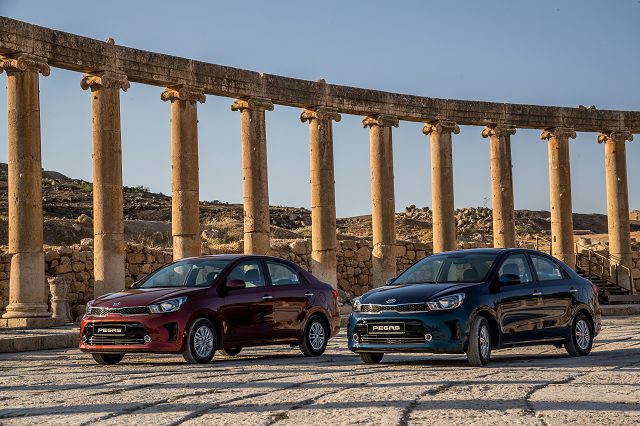- New B-segment sedan to enter Middle East market with efficient 1.4-liter gasoline MPI engine and choice of manual or automatic transmission
- Modern design with big personality and compact dimension
- Ideal for young families, with spacious, ergonomic cabin and 475-liter trunk
- Middle East sales commence in August 2019
Spacious, economical and highly practical, the new Kia Pegas compact sedan goes on-sale this month across the Middle East. Entirely new to the region, the Kia Pegas is a smart option for young families in urban areas. It features a big personality, compact dimensions, and generous storage and cabin space.
The Kia Pegas boasts a stylish exterior design and a spacious interior, as well as an array of convenience features and technologies to please B-segment sedan customers. Built by Kia in China, the car was introduced to several international markets in 2017.
“Pegas will be a great option for young families looking for a practical car that delivers the perfect combination of comfort, space, and the latest technologies,” said, Mr. James Kim, head of Kia’s Middle East and Africa regional headquarters. “This important new model will enhance the diversity of Kia’s model line-up in the region and will further strengthen the brand’s image. As our newest arrival goes on-sale in the Middle East, Kia now offers customers a greater choice of high-quality vehicles than ever before.”
Stylish, aerodynamic exterior design
The Pegas offers buyers in this class a uniquely stylish design, with sculpted body panels and bold character lines complemented by a striking color palette and a carefully-balanced sedan silhouette. The aerodynamic front of the Pegas, with a drag co-efficient of just 0.29 Cd, presents a bold ‘face’ to the world. Its deep bumpers incorporate sporty air curtain intakes in each corner, and a large trapezoidal air intake. The wide ‘tiger-nose’ grille extends into the headlamps, enhancing the sense of width and stability.
Viewed from the side, the profile of the Pegas gives it a finely-balanced silhouette. Its definitive character lines give the impression of motion, even while it sits stationary. The relatively long wheelbase and sloping tailgate visually enhances the length of the Pegas. The rear of the car is characterized by its sedan tailgate, with a subtle yet sporty ducktail profile to the trailing edge of the trunk lid and a pair of neat rear combination lamps.
Depending on market, the Pegas is offered with a choice of up to seven paint colors, ensuring there is a color for every personality. The car runs on 14-inch steel or aluminum alloy wheels.
Space, convenience and technology – and a capacious trunk
Inside, the cabin of the Pegas offers occupants maximum space and convenience. The center fascia has been designed to enhance ease-of-use, with many of the car’s functions controlled with clear, ergonomic buttons.
Additionally, the center console provides plenty of storage space to enhance usability, with built-in cupholders that can be reached from the front and rear of the cabin. A small two-level tray at the base of the dashboard can also be used to store occupants’ smartphones while on the move.
The multimedia system at the center of the dashboard is available with either a 3.8-inch display or an optional 7.0-inch touchscreen infotainment system. The larger screen features Bluetooth connectivity to enable Android Auto and Apple CarPlay as standard. The cabin can be equipped with either four or six speakers, depending on vehicle specification.
Providing owners with a sense of quality that goes beyond the expectations of compact sedan buyers, the cabin is finished with a series of design flourishes and high-quality materials.
The dashboard’s modern design is matched by circular rotatable air vents, finished with chrome and black high-gloss bezels, while speakers are integrated into the doors behind specially-designed grilles which extend backwards beneath the arm rest. A central arm-rest for front occupants, and a stylish cloth interior make the cabin more inviting. Height adjustable head-rests are standard for front-seat occupants, as well as tilt-adjustable driver’s seat base, helping the driver to find their ideal driving position.
Depending on market, the Pegas also offers height-adjustable head-rests for rear passengers. A 2,570 mm wheelbase – longer than many rivals, and equivalent to many vehicles from the class above – ensures the cabin offers generous legroom for all occupants.
Adding to the spacious cabin, the Pegas is also immensely practical for storing luggage. The trunk has a capacity of 475 liters, enough to store up to three golf bags, or a couple of large suitcases. As the trunk lid opens, illumination within the trunk also reveals any smaller items that could be forgotten.
Efficient gasoline engine and a range of electronic driver aids
The Kia Pegas is powered by Kia’s efficient 1.4-liter ‘Kappa’ MPI (multi-point injection) gasoline engine which produces a maximum output of 95PS at 6,000rpm and maximum torque output of 132 Nm at 4,000 rpm. Fuel economies vary in accordance with market regulations. In Euro2 markets, fuel efficiency is up to 6.0 liters per 100 kilometers and can travel up to 717 km between gas stops. In more stringent Euro4 markets, fuel efficiency of up to 6.1 liters per 100 kilometers and can drive up to 705km. The engine is available with a choice of five-speed manual or four-speed automatic transmissions.
Furthermore, the Pegas is equipped with an array of safety features, including four airbags, Electronic Stability Control (ESC), Vehicle Stability Management (VSM) and Hill Start Assist Control (HAC). ESC and VSM work in parallel to help keep the car stable and maintain traction under cornering. HAC briefly holds the car stationary with the brakes, enabling the driver to more cleanly accelerate from a standstill on an incline.
On-sale in the Middle East from August
The Kia Pegas is built in Yancheng, China by Kia Motors. Sales of the vehicle will gradually commence during August in key markets across the Middle East.














